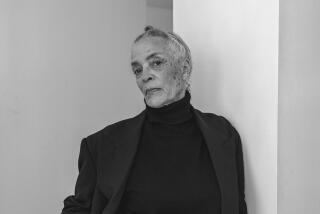Thwarted Artist Sketches New Path
- Share via
As a child, Kathleen Wigglesworth had a recurring dream. In it she was an angel with a magic wand, whose earthly job was to make things beautiful. Young Wigglesworth believed she’d one day become an artist or even an art teacher. But this was not to be.
Her mother discouraged such impractical vocations, declaring secretarial work a far better choice, Wigglesworth recounts today. So in the early 1970s, after receiving her bachelor’s degree in art education and feeling uncertain about her future, Wigglesworth dutifully took a secretarial position with a Wisconsin-based snowmobile manufacturer, then stayed on a corporate career track for the next 25 years.
Although the 49-year-old Claremont resident has worked her way up from administrative assistant to software sales associate at Hewlett-Packard in Los Angeles, she still thinks about the career path not taken and finds herself sketching portraits during rare idle moments at work.
“It’s a real dilemma for me, because HP has been a wonderful company to work for,” she said. “They treat employees respectfully, pay well and have a terrific benefits package.”
Wigglesworth consulted David Swanson, the Wisconsin-based chief of staff of the “What Color Is Your Parachute?” career lecture team. Swanson encouraged Wigglesworth to embark on a self-discovery journey to learn more about her passions, skills and aptitudes. She would begin by taking a battery of tests at https://www.jobhuntersbible.com, the Internet supplement to Richard Bolles’ book “What Color Is Your Parachute? 2000” (Ten Speed Press, 1999).
After reviewing Wigglesworth’s test results and consulting with her for two sessions, Swanson told her: “You’re a right-brained person who’s been in a left-brained game for so long, you’re like a fish out of water.” But he added that Wigglesworth had proved herself a valuable anomaly by demonstrating high competence at left-brained activities such as organizing and systematizing. This, he said, could make her quite marketable in the art world.
“You’d be an absolute godsend, a gift from heaven for art people,” particularly those lacking organization skills, he said.
Swanson encouraged Wigglesworth to do additional self-evaluation before choosing a career path. Because she loves organizing, she may want to find a vocation that will allow her to routinely use this skill. She also can explore various art disciplines to see which most appeal to her. And should she wish to maintain an affiliation with her current employer, she might contact the David and Lucille Packard Foundation in Los Altos, Calif., to learn about opportunities in its arts support program.
Swanson and several art vocation experts had these additional suggestions, based on Wigglesworth’s preliminary choices of potential art careers:
* Explore art conservation. Wigglesworth expressed interest in the demanding field of art conservation. But should she choose this profession, her road ahead would be challenging and time-consuming.
Art conservators strive to protect, preserve and restore art objects. They may be called upon to delicately treat tears, stains and surface dirt on precious works of art, said Mark Harnly, a conservator at the Getty Center in Brentwood. They also must inspect art objects and document their condition before and after transport, said Victoria Blyth-Hill, head of conservation at the Los Angeles County Museum of Art. And here in Los Angeles, they must be proficient in “earthquake mitigation,” making sure art objects are protected in the event of seismic activity, Blyth-Hill said.
To become a conservator, Wigglesworth would have to gain entrance to one of the three U.S. universities that offer graduate programs in art conservation: State University of New York/Buffalo, New York University or University of Delaware. Competition for the schools’ limited first-year spots is keen, and many candidates apply repeatedly before getting accepted.
Because of art conservation’s technical and scientific demands, Wigglesworth would have to take about a year’s worth of general and organic chemistry courses as prerequisites for the programs..
Before applying to grad school, Wigglesworth also would have to rack up field experience, perhaps as a volunteer at a regional conservation lab or as an aide to a conservator in private practice. Then with her grad school applications, she’d have to submit a portfolio of her artwork or conservation projects, said Chris Tahk, director of SUNY/Buffalo’s art conservation department.
If Wigglesworth doesn’t want to pursue a graduate degree in art conservation but still wishes to work in the field, she might consider becoming a conservation technician, aiding conservators in their daily work. Even as a conservation technician, however, she’d still need adequate knowledge of chemistry, said Penny Jones, executive director of the American Institute for Conservation of Historic and Artistic Works in Washington.
* Consider registrar work. Registrars are the “travel agents of art,” said Ted Greenberg, registrar at LACMA. They keep track of art objects and process incoming and outgoing loan agreements, gift deeds and purchase agreements. They issue accession numbers, or IDs, to art objects and research the objects’ ownership history. They also confirm that the pieces’ descriptions and records are up-to-date and accurate.
“We are ‘information central’ here,” Greenberg said. “I tell people who work for me, ‘You have to be accountable and accurate because the care of the collection is in your hands.’ ”
Top-flight registrars are patient, well-organized and logical, Greenberg said. Computer skills also are important. This makes the career a good possible choice for Wigglesworth, who’d be able to combine her love of art with her highly developed organization skills.
“For this job, you need to be a really detail-oriented person with the instincts of a detective,” said Jim Yood, lecturer and assistant chairman of the department of art theory and practice at Northwestern University in Evanston, Ill.
Indeed, sometimes registrars’ work proves to be exciting and significant. They may, for example, be asked to retrace the provenance of works that had been stolen by the Nazis during World War II. To do this, they study original documents, bills of sale, photographs, historical records and correspondence, among other things.
Should Wigglesworth be interested in pursuing a career as a registrar, she could enroll in an undergraduate museum studies program, then gain field experience, perhaps by volunteering as a registrar’s assistant at a small art institution, Greenberg suggested.
Lastly, although cataloging art objects at auction houses such as Christie’s and Sotheby’s might be something Wigglesworth would enjoy, it’s not a career she could pursue right away.
Cataloging tends to be the responsibility of auction-house art specialists, who come to their jobs with encyclopedic knowledge of an art subject, such as Old Master paintings, Impressionist works or even Hollywood memorabilia, said Andrea Fiuczynski, Christie’s senior vice president and director of business development in Beverly Hills.
To follow this career path, Wigglesworth would need to gain additional education and training, then develop expertise--through private collecting, museum work or academic study--in a particular area of study about which she’s passionate, Fiuczynski said.
Wigglesworth says she may explore other art-related vocations--art education administration, crafts gallery ownership, even religious mosaic restoration. But she knows one thing: She wants to renew her childhood commitment to artistic beauty.
(BEGIN TEXT OF INFOBOX / INFOGRAPHIC)
Time for a Change
Name: Kathleen Wigglesworth
Occupation: Software sales associate
Desired occupation: Arts-related job
Quote: “For a long time, I thought I didn’t have any passion, but talking about [art] makes me realize that I still have it. I just pushed it away somewhere.”
Counselor’s recommendation
Do intensive self-assessment
Create a list of job activities she’d greatly enjoy
Investigate the top vocational choices that would allow you to perform these activities.
Meet the Coach
David Swanson is a Wisconsin-based workshop leader and public speaker specializing in career development, marketing, motivation and productivity. He has served on the national “What Color is Your Parachute” career lecture team for 20 years.
More to Read
Sign up for our Book Club newsletter
Get the latest news, events and more from the Los Angeles Times Book Club, and help us get L.A. reading and talking.
You may occasionally receive promotional content from the Los Angeles Times.










